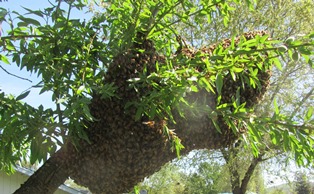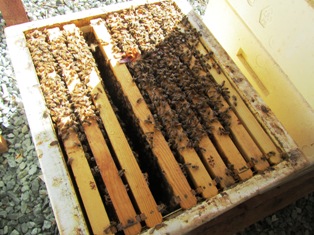Streak of Warm Weather Starts Seasonal Bee Swarms
Last Wednesday heralded the official onset of spring. And it sure felt like it around the East Bay. The local beekeepers became more watchful as increasing bee traffic predicted an increased likelihood of swarms.
Last year, we rescued more than a dozen swarms from neighborhood trees as far away as two miles. Bees will fly up to five miles in search of food (they also need water), returning to their hives before darkness and the cool night air sets in.
Swarming is the way honeybees increase their numbers. The queen lays eggs throughout the winter and in spring, the hive will need more room to accommodate all the new offspring. Beekeepers can add “extensions,” but swarms will still happen.
The first swarm of the season found its way to my almond tree on the day before Easter. I had vigorously pruned the branches two years ago after discovering some limbs badly diseased. But the tree rebounded with hundreds of small, thin branches. The weight of the massive swarm caused the branch to give way. The bee swarm fell apart.
In less than a minute, the honeybees were again huddled around their queen on a thicker, stronger branch.
A styrofoam super with frames already inserted was placed under the branch. All it took was a couple of hard shakes of the limb to knock the bees in their new home.
The lid of the super was reattached and the box positioned so that the opening (the bees’ front door) faced the tree. The swarm would find safe haven inside the super as night approached.
After dusk, the super was turned from its western-facing direction to ensure that the bees’ front door faced east, the direction of the sunrise. Bees love the light and warmth of the sun.
Around the top of the super, some of the honeybees did a tail-waggle dance. My beekeeper neighbor told me it was their way of telling the other bees that this was their new home; to, “come on in.”
I guess those little fellows doing the waggle dance were the welcoming party.
 Facebook
Facebook Goodreads
Goodreads LinkedIn
LinkedIn Meera Lester
Meera Lester Twitter
Twitter






